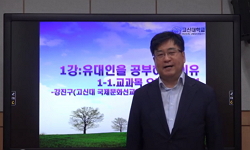This study dealt with several aspects of the Levantine Arab`s way of thinking through three motifs of sex, social life, and religion. Furthermore, I tried to understand to what extent sacredness is linked with profaneness in the Levantine Arab`s minds...
http://chineseinput.net/에서 pinyin(병음)방식으로 중국어를 변환할 수 있습니다.
변환된 중국어를 복사하여 사용하시면 됩니다.
- 中文 을 입력하시려면 zhongwen을 입력하시고 space를누르시면됩니다.
- 北京 을 입력하시려면 beijing을 입력하시고 space를 누르시면 됩니다.

레반트 민담 텍스트를 통해 본 레반트 인의 의식구조 연구: 성(性), 사회생활, 종교 모티프를 중심으로 = A Study on the Levantine Arab`s Way of Thinking through the Texts of Levantine Folk Tales: Concentrating on the Motifs of Sex, Social Life, and Religion
한글로보기https://www.riss.kr/link?id=A76618849
- 저자
- 발행기관
- 학술지명
- 권호사항
-
발행연도
2009
-
작성언어
-
- 주제어
-
KDC
790
-
등재정보
KCI등재
-
자료형태
학술저널
-
수록면
159-198(40쪽)
-
KCI 피인용횟수
0
- DOI식별코드
- 제공처
-
0
상세조회 -
0
다운로드
부가정보
다국어 초록 (Multilingual Abstract)

This study dealt with several aspects of the Levantine Arab`s way of thinking through three motifs of sex, social life, and religion. Furthermore, I tried to understand to what extent sacredness is linked with profaneness in the Levantine Arab`s minds. I selected and analyzed 22 Levantine folk tales relevant to the three motifs. First, I found that the Levantine folk tales reveal the Arab`s positive attitude toward sex by describing the women`s body and attractiveness, and the man-woman sexual relationships. I think that the Arab`s openness toward the matter of sex is related to Islam itself which is characterized by moderation in sex, that is, Islam does not prohibit abstinence. However, some stories of sex in the folk tales go beyond a tolerance limit, reaching the extent of immoderation. I am of an opinion that this phenomenon represents the cosmic creation of man, or it symbolizes the man`s desire to procreate. Second, as for the motif of social life, I observed the relationship between the Moslems and the Jews in Levant. Some stories reveal Moslems` antipathy toward the Jews by describing them as a wicked and cruel people who lack humanity and sympathy. I assume that such phenomenon of anti-Semitism is based on the historical fact that the Jews revolted against Muhammad, the prophet of Islam, in the early Islamic period and is partly due to Moslems` deep distrust toward the Jews who, as a minority and belonging to the low class, resorted to duplicity for their survival. Third, in relation to the motif of religion, I took note of three issues. The first one is the issue of the teachings of Islam based on the regulations of halal (s.th. allowed) and haram (s.th. forbidden), which are represented in the folk tales. In this regard, I found some examples of the teachings including the prohibition of magic, full respect for a creature`s life, compassion for all creatures, and rigid customs of wearing hijab (long gowns) for women. The second issue is related to the worship of wali (a holy man in Islam). The analysis of the folk tales shows that although the official Islam prohibits the believers from relying on the power of the holy man, many Arabs look forward to the karamah (miracle) of the holy man. In the belief that the holy man is closer to Allah and, as such, functions as a mediator between Allah and themselves, the Arabs depend on him to solve their problems. The third issue talks about human suffering in the mundane world. Some stories attribute this suffering as the fate of humans for not being able to free themselves from committing sins of desires; therefore, they could not help from falling into anguish. It shows a view of Islam that a man is the being of finiteness, always suffering from his fate. In conclusion, the Levantine folk tales show that the Arab`s way of thinking in Levant is based on Islamic values and institutions. They also describe the Arab`s historical experiences and various elements of human nature including worldly desires. The folk tales support my argument that, in the Arab`s consciousness, elements of sacredness based on Islamic official teachings are in harmony with elements of profaneness which stem from their popular beliefs and traditional customs.
참고문헌 (Reference)
1 하지사브리, "하디스, 부록-무함맏 전기(傳記)" 한국이슬람교중앙연합회 1978
2 공일주, "코란의 이해-공식 이슬람과 민속 이슬람" 한국외국어대학교 출판부 2008
3 루이스, 버나드, "중동의 역사" 까치 2007
4 손주영, "제 4장: 중동인의 종교, 이슬람의 이해 in: 중동의 새로운 이해" 도서출판 오름 1999
5 김능우, "이집트 민담 텍스트를 통해 본 이집트인의 의식구조 연구" 한국아랍어아랍문학회 11 (11): 153-191, 2007
6 테르카이트, 무함마드 A. R., "이슬람의 전통과 생활관습" 도서출판 알림 2002
7 이광호, "이슬람과 한국의 민간신앙" 울산대학교 출판부(UUP) 2003
8 손주영, "이슬람: 교리, 사상, 역사" (주)일조각 2005
9 존슨, 폴(Paul Johnson), "유대인의 역사2: 유럽의 역사를 바꾸다" (주)살림출판사 2005
10 벤츠, 볼프강, "유대인 이미지의 역사" 푸른역사 2005
1 하지사브리, "하디스, 부록-무함맏 전기(傳記)" 한국이슬람교중앙연합회 1978
2 공일주, "코란의 이해-공식 이슬람과 민속 이슬람" 한국외국어대학교 출판부 2008
3 루이스, 버나드, "중동의 역사" 까치 2007
4 손주영, "제 4장: 중동인의 종교, 이슬람의 이해 in: 중동의 새로운 이해" 도서출판 오름 1999
5 김능우, "이집트 민담 텍스트를 통해 본 이집트인의 의식구조 연구" 한국아랍어아랍문학회 11 (11): 153-191, 2007
6 테르카이트, 무함마드 A. R., "이슬람의 전통과 생활관습" 도서출판 알림 2002
7 이광호, "이슬람과 한국의 민간신앙" 울산대학교 출판부(UUP) 2003
8 손주영, "이슬람: 교리, 사상, 역사" (주)일조각 2005
9 존슨, 폴(Paul Johnson), "유대인의 역사2: 유럽의 역사를 바꾸다" (주)살림출판사 2005
10 벤츠, 볼프강, "유대인 이미지의 역사" 푸른역사 2005
11 김능우, "아랍민담을 통해본 아랍인의 삶: 아랍인의 성(性) 의식" 한국아랍친선협회 2007
12 하마디, 사니아, "아랍, 아랍인 바로 알기-아랍인의 의식구조" 도서출판 큰손 2000
13 김능우, "세계민담전집 13-아랍 편" (주)황금가지 2008
14 엘리아데, M., "성(聖)과 속(俗)" (주)도서출판 한길사 2005
15 김용선, "성(聖) 꾸란-이슬람 경전 상(上), 중(中), 하(下)" 박영사 1983
16 김능우, "마그립 민담 텍스트를 통해 본 마그립인의 의식구조 연구: 성(性), 사회생활, 종교 모티프를 중심으로" 한국아랍어아랍문학회 12 (12): 139-187, 2008
17 "“현대사회와 기층문화”(정담(鼎談): 이사현, 한상복, 이경숙), 대학신문, 서울대학교 대학신문사, 제 1043호, 15면, 1978년 11월 29일자"
18 Aswad, Nizār, "al-Ḥikāyāt al-Shaʿbiyah al-Shamiyah" Maṭbaʿah al-Jumhūriyah
19 ʿAssāf, al-Shaykh Aḥmad Muḥammad, "al-Ḥalāl wa al-Ḥarām fī al-Islām" Dār Iḥyāʾ al-ʿUlūm 1997
20 Ubayd, Manṣūr al-Rifāʾī, "al-Siḥr wa al-Ḥasad wa al-Rabṭ baynahumā" Markaz al-Kitāb li-l-Nashr 2008
21 Bāqī, Muḥammad Fuʾād ʿAbd, "al-Muʿjam al-Mufahras li-Alfāẓ al-Qurʾān al-Karīm" al-Maktabah al-Islāmīyah 1982
22 Shaltūt, Maḥmūd, "al-Islām ʾAqīdah wa Sharīʾah" Dār al-Shurūq 2007
23 Ziriklī, Khayr al-Dīn, "al-Aʿlām" Dār al-ʿIlm li-l-Malāyīn 1984
24 Hitti, Philip K., "Tārīkh al-ʿArab" Dār Ghandūr li-l-Ṭibāʿah wa al-Nashr wa al-Tawzīʿ 1990
25 Qaradawi, Sheikh Yusuf, "The Lawful and the Prohibited in Islam, al-Falah Foundation for Translation" Publication & Distribution 2005
26 Bouhdiba, Abdelwahab, "Sexuality in Islam" Saqi Books 1998
27 Khayyat, Shimon L., "Relations between Muslims, Jews and Christians as Reflected in Arabic Proverbs" 96 (96): 190-207, 1985
28 Ibn Sirin, "Muntakhab al-Kalam fi Tafsīr al-Aḥlām" al-Muʾassasah al-Ḥadīthah li-l-Kitāb
29 Ghazālī, Muḥammad, "Miʾah Suʾāl ʿan al-Islām" Dār Thābit 1983
30 Forward, Martin, "Islam in: Human nature and Destiny" Pinter Publishers Ltd. 91-115, 1994
31 Ali, Maulana Muhammad, "A Manual of Hadith" Curzon Press 1988
동일학술지(권/호) 다른 논문
-
아랍어 완료형과 미완료형의 의미 연구 -코란 구절을 바탕으로
- 한국아랍어·아랍문학회
- 이명원 ( Myong Won Lee )
- 2009
- KCI등재
-
- 한국아랍어·아랍문학회
- 정규영 ( Kyu Young Jung )
- 2009
- KCI등재
-
- 한국아랍어·아랍문학회
- Doaa Ghareeb
- 2009
- KCI등재
-
ثقافة المعاناة وسيميولوجية المفارقة قراءة في رواية "القزم يطلق الكرة الصغيرة"
- 한국아랍어아랍문학회
- 두아 가리브
- 2009
- KCI등재
분석정보
인용정보 인용지수 설명보기
학술지 이력
| 연월일 | 이력구분 | 이력상세 | 등재구분 |
|---|---|---|---|
| 2026 | 평가예정 | 재인증평가 신청대상 (재인증) | |
| 2020-01-01 | 평가 | 등재학술지 유지 (재인증) |  |
| 2017-01-01 | 평가 | 등재학술지 유지 (계속평가) |  |
| 2013-01-01 | 평가 | 등재 1차 FAIL (등재유지) |  |
| 2010-01-01 | 평가 | 등재학술지 유지 (등재유지) |  |
| 2007-01-01 | 평가 | 등재학술지 선정 (등재후보2차) |  |
| 2006-01-01 | 평가 | 등재후보 1차 PASS (등재후보1차) |  |
| 2004-07-01 | 평가 | 등재후보학술지 선정 (신규평가) |  |
학술지 인용정보
| 기준연도 | WOS-KCI 통합IF(2년) | KCIF(2년) | KCIF(3년) |
|---|---|---|---|
| 2016 | 0.13 | 0.13 | 0.12 |
| KCIF(4년) | KCIF(5년) | 중심성지수(3년) | 즉시성지수 |
| 0.1 | 0.1 | 0.402 | 0.1 |




 KCI
KCI 스콜라
스콜라




